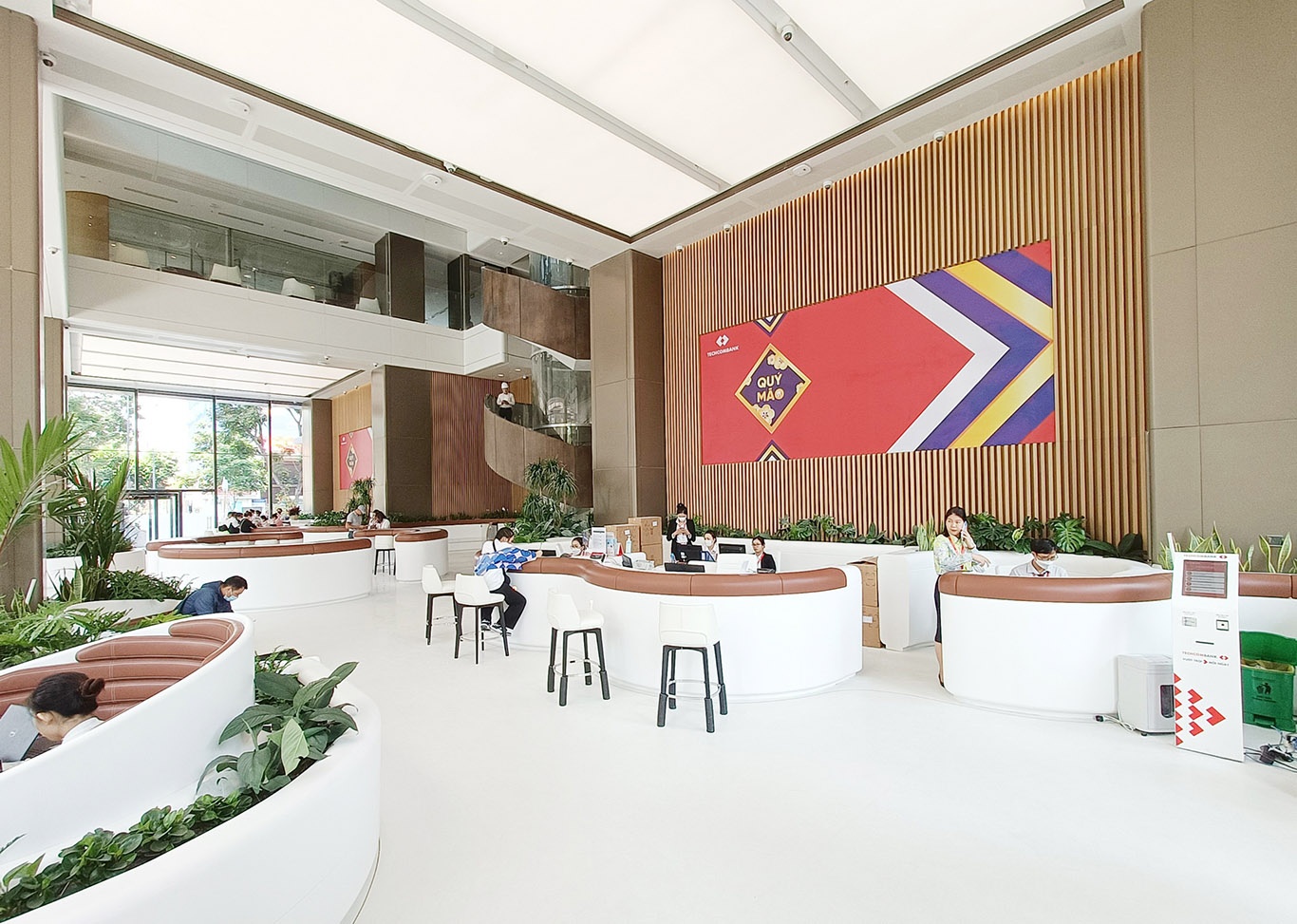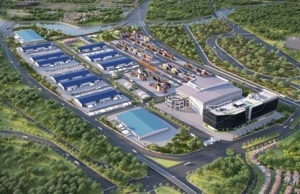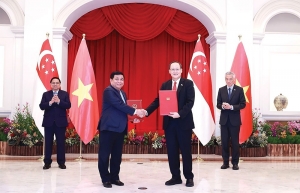Techcombank confident about 2025 targets despite headwinds
On April 22, Techcombank held its 2023 AGM. At the press briefing afterward, CEO Jens Lottner showed confidence in the bank’s ability to achieve its 2025 targets and remained optimistic about the underlying attractiveness of the Vietnamese economy despite recent market volatility.
According to Lottner, "Vietnam’s economy recovered well in 2022, but with higher borrowing costs, tighter credit, and slower GDP growth in the first quarter of 2023, the economy still faces significant challenges."
For the banking sector in particular, the high-interest rate environment and tight liquidity have continued to push up the cost of funds, compressing the net interest margin. While volatility in the bond and real estate markets, where Techcombank has a strong presence, has also had a particular impact on the bank's recent performance.
 |
Despite these temporary headwinds, Lottner explained, "Techcombank’s strategy is to hold steady in the third year of its five-year transformation journey and its medium-term objectives and targets remain unchanged. Digital transformation accelerated significantly in 2022, with investments in digital technologies positioning the bank well for growth and helping to accelerate customer acquisition."
Techcombank successfully deployed important digital platforms for its retail and business customers last year, including the Techcombank Mobile and Techcombank Business apps.
Today, around 90 per cent of Techcombank’s customer transactions are conducted on the bank’s digital platforms and its apps are among the highest rated in the market.
| In the first half of 2023, Techcombank has so far experienced a lot of corporate lending activity due to demand for short-term credit from its business customers. |
Even more importantly, customer engagement on these platforms is very high compared to local, regional, and even global banking peers.
According to Lottner, Techcombank is investing in digitalisation to create a seamless customer experience, online and offline.
"It's a complex process that requires investment in underlying capabilities and technologies and the integration of different systems and platforms across the bank," he said, “But I believe that the technology we have in place, and are in the process of connecting, puts us around two or three years ahead of anyone else in the market.”
Techcombank is employing technologies, including AI, to create human-like interactions with customers over digital platforms, analyse data to understand the needs of individual customers, and offer each customer the right products and services throughout their financial lives.
“Through the application of technology, our acquisition cost per customer is coming down. But what we can deliver to our customers is expanding,” explained Lottner. In the past, Techcombank had been increasing its customer base by about one million per year. This year, Lottner says the bank is aiming to add 2-3 million new customers in 2023, primarily through digital channels.
Focus on retail credit
According Lottner, Techcombank plans to allocate more of its credit quota to retail customers and small- and medium-sized enterprises (SMEs) over time in an effort to diversify its credit book.
Simultaneously, this will reduce the bank’s exposure to corporate lending in the real-estate sector, improving risk-diversification. By increasing lending to retail and SMEs, Techcombank aims to broaden its exposure to growing sectors within the economy, such as fast-moving consumer goods, auto, utilities, and others.
Furthermore, Lottner explained that when the bank allocates credit, it looks at the potential return on a risk-adjusted basis and across the full customer relationship.
"This means that even if the return is lower from lending to a retail or SME customer, the bank hopes to deepen and expand its relationship to include other products, like credit cards. So, the overall risk-adjusted return from retail and SME customers can actually be higher than from corporate clients," he said.
In the first half of 2023, Techcombank has so far experienced a lot of corporate lending activity due to demand for short-term credit from its business customers. However, the strategic shift of the bank's credit book to retail and SME’s is expected to resume in the second half of the year as demand returns.
On track to meet CASA target
Techcombank has a current account/saving account (CASA) ratio target of 55 per cent by 2025, but in 2022 it reported a CASA ratio of 37 per cent. Increasing the CASA ratio is a top priority for the bank and, according to Lottner, it is still on track to reach this target.
Despite recent volatility in the real estate and bond markets, Lottner remains optimistic about the underlying attractiveness there.
This means that as customer confidence returns, and interest rates fall, so appetite among affluent customers for bonds, stocks, and real estate will rise. The need to move money in and out of assets will lead to a shift from term deposit accounts back into CASA.
Techcombank is already among Vietnam’s top transaction banks, but Lottner explained that to cater for the expected rise in demand for such investments among affluent customers, it is creating a new and holistic wealth management proposition.
“As the market returns, we believe there will be a need for traditional wealth products, such as bonds or real estate, and we understand what our affluent customers are looking for.”
Today, Techcombank is working hard to strengthen its wealth proposition through better products allied with more experienced relationship managers and advisory processes to ensure the bank is ideally suited to the individual risk-return expectations of every customer.
For SME customers, Techcombank is also strengthening its offerings around transaction banking, while simultaneously enhancing its credit underwriting capabilities.
CASA and credit go hand in hand, as Lottner explained, “People who take credit from us have much higher CASA balances. So, as we start deploying credit into SMEs, CASA figures should increase."
On the corporate banking side, Techcombank plans to launch new cash and liquidity management and treasury management services.
For merchants, the bank is preparing to launch a series of new offerings in the coming months while it is also releasing a host of new digital features and functionalities to drive online retail customer engagement, as well as new rewards and loyalty platforms.
“Are we still on track? I'm actually very confident of hitting our target of 55 per cent CASA ratio if we continue to follow our strategy,” said Lottner.
Investing for the future
The performance of Techcombank has enabled it to invest in digital transformation ahead of most other banks in Vietnam.
The bank has increased investment in-line with growth in total operating income (TOI). However, growth in TOI slowed due to market headwinds last year, but the bank continued with its digital transformation and cloud transition strategy.
Techcombank has already made much of this investment and should, in the medium term, see a slowdown of its additional investments into data and technology while competitors are only beginning a similar investment cycle.
While this investment may cause a temporary rise in Techcombank’s cost-to-income ratio, the investment made today will drive future growth and should drive costs down in the future, while other banks might see the reverse.
Lottner believes Techcombank is still leading the digital transformation of the banking industry in Vietnam, and there is mounting evidence that proves his decision to adapt early has been correct.
"All banks in Vietnam will need to invest significantly in digital technologies if they are to meet the evolving needs of customers and keep pace with the industry," Lottner said.
 | Ambitious action plan needed to lure international tourists Vietnam already has an ambitious tourism development strategy in place, but the country needs a concrete action plan to attract more international tourists. Doan Van Binh, vice president of the Vietnam Real Estate Association, told VIR about solutions to boost international tourist arrivals. |
 | Vietnam’s logistics industry looks bright despite headwinds Vietnam’s logistics industry remains a bright spot amidst intensifying headwinds in the global market. |
 | Singapore and Vietnam ties on track Vietnam and Singapore are intensifying their bilateral ties in new fields, focusing on digital economy and innovation, infrastructure, and energy, which will help businesses in both economies to benefit from new forms of cooperation. |
 | Vietnam’s economy steadfast amid the headwinds The government and people of Vietnam well deserve their achievement of the highest economic growth record in more than a decade. Despite global economic concerns, inflationary pressure, currency depreciation and other current challenges, Vietnam’s economy grew at 8.02 per cent in 2022, according to the General Statistics Office. That was higher than the government’s initial target of 6-6.5 per cent, and Vietnam remains one of the fastest-growing economies in the region. |
What the stars mean:
★ Poor ★ ★ Promising ★★★ Good ★★★★ Very good ★★★★★ Exceptional
Related Contents
Latest News
More News
- Tax sector wraps up 2025 and sets priorities for next year (December 25, 2025 | 14:00)
- A tipping point for digital and hybrid wealth management in Vietnam (December 23, 2025 | 13:33)
- $250 million deal targets women-owned SMEs, sustainable agriculture (December 22, 2025 | 17:40)
- Stock market posts resilient 2025 performance (December 19, 2025 | 18:17)
- Citi Vietnam receives 2025 AmCham CSR recognition (December 19, 2025 | 16:35)
- As global green supply chain reshapes, will Vietnam be left behind? (December 19, 2025 | 08:00)
- Banks gear up for massive capital increases (December 18, 2025 | 17:04)
- Securing capital and efficiency for Vietnam’s 2026-2030 growth ambitions (December 17, 2025 | 10:00)
- Energy sector in need of blended finance mechanisms (December 17, 2025 | 09:00)
- Vietnam still has room to mobilise capital for sustainable growth (December 17, 2025 | 08:57)

 Tag:
Tag:

























 Mobile Version
Mobile Version